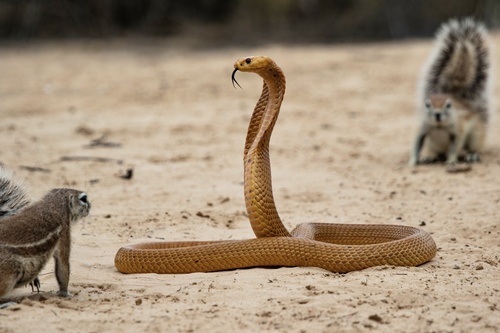
Cape Cobra
The Cape cobra (Naja nivea), a versatile predator, displays a striking hood when threatened. Found in southern Africa's varied landscapes, its color ranges from sunlit gold to earthy brown, reflecting its environment. As an apex predator, it helps maintain ecological balance by managing rodent populations.
12-20 years
Lifespan
Length: 1.194 m
Size
Brown, Yellow, Black
Color
High
Aggression
Least Concern
Conservation Status
Stable
Population Trend
Characteristics
Naja nivea, commonly known as the Cape cobra, is a highly venomous snake native to southern Africa. It thrives in diverse habitats, from deserts to savannas. Notably variable in color, it can range from yellow to brown. This cobra is known for its defensive hood display and plays a crucial role in controlling rodent populations.
Distribution Range of the Cape Cobra
Naja nivea, commonly known as the Cape cobra, is native to southern Africa. It is predominantly found in South Africa, Namibia, and Botswana.
Cape Cobra's Habitat
Environmental Conditions
The Cape cobra inhabits a variety of environments, including deserts, semi-deserts, savannas, and scrublands. It is commonly found in arid and semi-arid regions, often near water sources such as rivers and streams.
Ecological Niche
Naja nivea primarily occupies terrestrial habitats but is also known to climb trees and shrubs. It is an opportunistic feeder, preying on small mammals, birds, lizards, and other snakes. Its adaptability to different environmental conditions allows it to thrive in diverse habitats, from sandy deserts to rocky outcrops and bushveld areas.
Copyright @ Nature Style Limited. All Rights Reserved.
 English
English